|
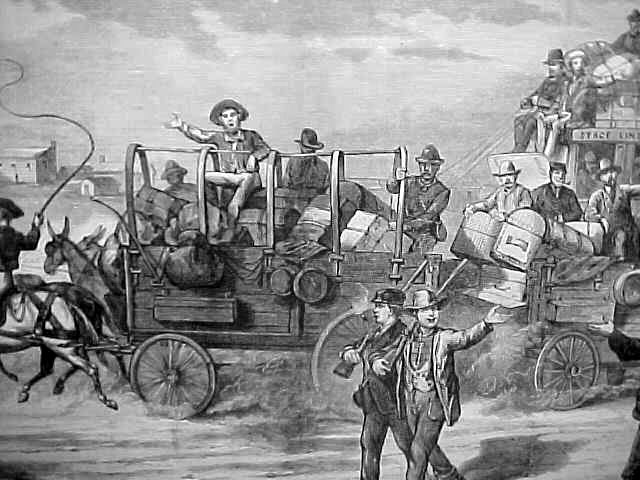
Cheyenne, 1877, Woodcut, Leslies Illustrated News
The above depicts a freight wagon heading off for the gold rush in the Black
Hills of Dakota Territory and is the center section of the woodcut on the
preceding page. Note that the wagon is tandem. The horses pulling the wagon are depicted in the next panel.
Mrs. Leslie described the scene:
"The accompanying sketch of Black Hillers starting from Cheyenne is a representation
of an emigrant team as we saw it starting from Cheyenne for the
Black Hills, a stage for the same destination being in the
immediate background. The freight and passenger traffic to this new
Eldorado is now assuming enornous proportions. The stage
company sent out six first and twenty second-class passengers on that
day, and they stated that their average for a long time had been ten first and twenty
second per day, while there are many going with their own teams and various freighting "outfits."
The stage runs carrying the mail daily, for Deadwood, and also from Sydney, another point
on the Union Pacific, six days per week. A trustworthy gentleman, just in from Indian
Creek, about one and one-half days' journey towards the Black Hills, stated
that he met about one hundred freight teams with three to ten passengers
apiece, between that point and Fort Laramie, while there were about one
hundred and fifty between the fort and Cheyenne, making from 1,000 to
1,200 persons en route to the Hills * * * *
The trip by wagon to the Black Hills could be grueling. Ellis Peirce kept a log for for his 24-day bull train trip
to the Black Hills in February and March, 1876:
NIGHT
1st, Crow Creek
2nd, Fred Schwartz'
3rd, Horse Creek
4th, Bear Springs
5th, Chugwater
6th, Chimney Rock P.O.
7th, Jack Hunton's Ranch
8th, Chug Springs
9th, Eagle's Nest
10th, Six Mile Ranch
11th, Ft. Laramie
12th, Government Farm
13th, Rawhide
14th, Rawhide Springs
15th, Running Water
16th, Hat or Spring Creek
17th, Indian Creek
18th, Down Indian Creek
19th, Cheyenne River
20th, Red Canyon
21st, Last Water
22nd, Spring on right
23rd, Pleasant Valley
24th, Custer City |
MILES TRAVELED
00
18
10
10
14
10
04
04
07
10
06
14
15
10
08
17
08
19
33
04
12
14
14
09
|
FROM CHEYENNE
00
18
28
38
52
62
66
70
77
87
93
107
122
132
140
157
165
184
217
221
233
247
261
270
|
See Map Crow Creek to Bordeaux (Hunton's Ranch).
See Map Bordeaux to Rawhide.
See Map Rawhide Buttes to Robbers Roost Creek.
Use "Back" button to return.
One of the more intriguing loads leaving Cheyenne's Elephant Corral was reminiscent of the story of Dick Whittington. It was a load of cats hauled by
independent freighter "Phatty" Thompson. Thompson had been alerted that some of Deadwood's "hotels" were overrun
by rodent. The rodents disturbed the inmates in their work. He employed a group of Cheyenne boys to gather
stray cats, paying the boys twenty-five cents each. One angry Cheyenne householder threated bodily harm to
Thompson when the householder's wife's pet Maltese disappeared. Along the route to Deadwood, either at Lightening Creek or
Spring Creek depending upon the source, Thompson's wagon overturned, freeing the cats. By tempting the
cats with food, Thompson was able to herd the cats and get them back into the big cage. In Deadwood, the cats allegedly
brought $10.00. A Maltese was sold for $25.00.
The Elephant Corral undoubedly took its name from a similar corral in Denver. It was essentially a
freight terminal for the freight wagon trains of the day. Horses, mules, and oxen would be bought and sold. Loaded wagons
could be stored in the corral. According to Wilbur Fiske Stone, History of Colorado,
S. J. Clarke, 1918, the Elephant Corral derived its name from its size. The one in Denver
was originally established by Jim Carlisle, James McNassar and Clarlie Blake. It extended from
Wazee to Blake Street. Its western boundary was 14th Street.
In 1876, with the discovery of gold in the Black Hills, a gold rush to Deadwood began. Cheyenne was promoted
by the Union Pacific through pamphlets such as Robert E. Strahorn's The Hand-Book of Wyoming and
guide to the Black Hills and Big Horn Regions for Citizens, Emigrant and
Tourist as the shortest and safest route the the Black Hills.
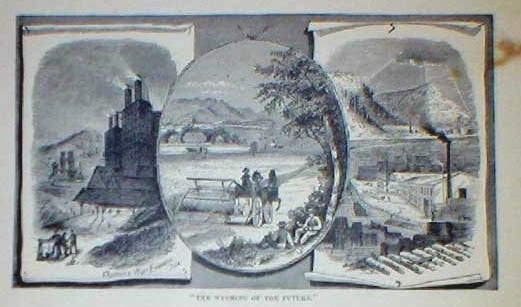
"Wyoming of the Future," woodcut,
The Hand-Book of Wyoming, 1877.
Robert E. Stahorn, an early settler in Cheyenne and self-styled "Alter Ego
of the Western Press," was a war correspondent during the Civil War and accompanied Gen. Crook's
expedition to Rosebud. Jay Gould, in control of the Union Pacific, employed
Strahorn to hype the west as a means of promoting settlement. Strahorn's wife,
Carrie Adell Strahorn in her 1911 10,000 Miles by Stage recalled overhearing a
teary emigrant bewailing, "If this is Strahorn's paradise, as his book calls it,
I just wish that he had to live in it, that's all, but I wish I was back
in Missouri where we'uns come from". The lady little realized that Strahorn at that
very moment was passing by.
Notwithstanding that
the gold fields were 246 miles to the north through an empty country inhabited only by wild Indians,
Cheyenne became the jumping-off point for those seeking fortune, the Skagway as it were for
the Black Hills gold rush. A hundred men a day headed north. At first, the increased business was welcomed
and the dangers from the Indians were downplayed. Thus, the editor of the
Weekly Leader on May 13, reassured his readers that the
road was safe, being properly patroled by Capt. James Egan and
"there have not been twelve men wounded by the Indians in the last three weeks."
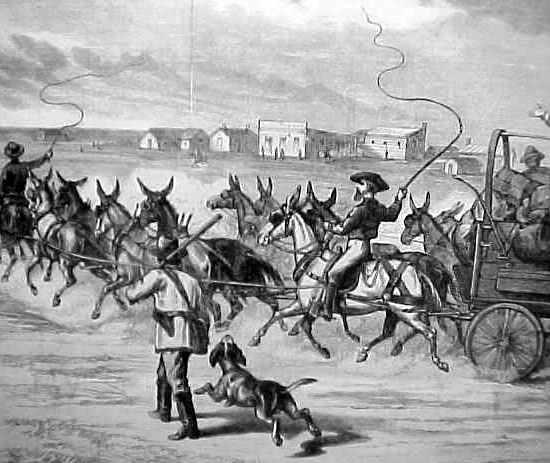
Cheyenne, 1877, Woodcut, Leslies Illustrated News
The dangers, however,
continued and the editor rapidly changed his tune, reporting in the May 20 edition:
In almost every issue of the LEADER we are compelled to chronicle the murder of some
of our citizens by the savages who infest our borders. Day after day the telegraph
brings to us the particulars of horrible atrocities committed upon the
people of Wyoming and Dakota by the fiendish and blood-seekings Indians,
whom by the Government, under so-called treaty stipulations, is feeding and supporting with the
utmost generous liberality."
In early July, reports began to filter
into Cheyenne of Indian attacks upon isolated ranches along the North Platte. Word had not yet been received
of Custer's demise. In early August, word was received that about ten miles from present-day Glendo Indians had attacked a
wagon train belonging to Alexander H.
"Heck" Reel, a Cheyenne liveryman and freighter. The wagon train was
carrying supplies for Fort Fetterman from the Army's vittling yard at Camp
Carlin. It was slightly more that two days out from Fetterman on the three
week trek. Reel's wagon master, George Trostle, was killed and scalped.
Two others were wounded. Three wagons were burned, destroying, among other items,
10,000 pounds of bacon and 40 barrels of beer. The wagon company circled most of the
wagons as a corral. The men used 5,000 pounds of flour as breastworks. Through the night, the seige continued
illuminated by the two-hundred foot high flames from the bacon.
The second boss, Sylvester "Vess" Sherman, stated that the
"men could see well enough to have picked up a pin in the corral." Also killed in the attack were
ten oxen, four horses, and a dog belonging to a Mexican teamster.
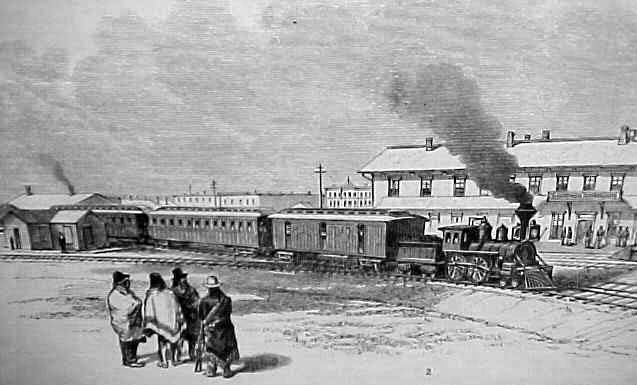
Union Pacific Depot, Cheyenne, 1877, Woodcut, Leslies Illustrated News
In the front is depicted
the Union Pacific Depot and Hotel. In the center background is the Inter-Ocean
Hotel, owned by Barney Ford and futher discussed on later Cheyenne Pages. Toward the
bottom of the page is another view of the Inter-Ocean.
The hordes of miners also changed the atmosphere of the city, tending, once again,
to give it a "Hell on wheels" aura. The editor of the Leader complained on
February 12 that Denver gamblers and sneaks had arrived; that Denver, "[t]hat
dying town seems to be 'taking a puke' as it were, of this class of citizen."
Among the Denver gamblers who opened new establishments in Cheyenne was "Big Ed" Chase. In Denver Chase was
a partner in the "Heatley and Chase Progressive Club" and the Palace Theatre, gaming parlor, and
saloon near Fifteenth and Blake Streets. Thus,
the proprietors of the Senate Bar, the Excelsior Saloon, and Frenchy's Place took
full advantage of the new business.
But if Denver disgorged its undesirables on Cheyenne, Cheyenne made a similar
contribution to Deadwood. In June 1876, C. H. "Charley" Utter's infamous wagon train passed through
town on its way from Denver to Deadwood. In Cheyenne, it relieved the city of Madames Elanora "Madam Mustache" Dumont and
"Dirty Emma" with their respective "boarding houses" of "working girls." Others who departed on the
wagon train included Abilene's former "pimp" marshal Wild Bill Hickok,
who had taken up residence in Cheyenne. The reference to "pimp" was as a result of his sartorial preference of a
red sash around his waist. It may very well be that Wild Bill had worn out his welcome in Cheyenne. At Boulder's gambling
establishment, Wild Bill assaulted the proprietor with his cane after Bill lost several hands and the
proprietor would not increase the house limits up to $50.00. Hickok then held off the bouncers with a
revolver as he scooped up money out of the drawer. Bill then calmly returned to his room at Dyer's Hotel on the west side
of Eddy Street (now Pioneer).
At Fort Laramie, the train, consisting of some
30 wagons, paused long enough for the
army to escort Calamity Jane to the train from the guard house where she had
been "sleeping it off."
In the Rocky Mountain West, it was common to
use Shutler wagons, which were noted for their gaudy paint jobs. Indeed, in Laramie City
the editor of the Boomerang, Bill Nye, was threatened with a shoot-out by teamster James M. Sherrod when Nye referred to
Sherrod's wife as being "painted up like a Shutler wagon."
Thus, upon its arrival in Deadwood City, the wagon train was greeted by the cheers of lonely miners.
The wagons must have been a
sight to behold, laden as they were with some 180 members of Cheyenne's sporting class. The cargo and passengers included assorted gamblers, musicians, nymphs du pave, and
37,000 lbs. of flour. It is doubtful the cheers of the boys were for the flour. Others who left Cheyenne for Deadwood included
traveling musicians Richard "Banjo Dick" Brown and Fanny Garrettson. Fanny left behind in Cheyenne her
paramour Edward Shaughnesy. Shaughnesy pursued the duo to Deadwood. On November 18, 1876, the sounds of Brown's banjo emitted from
the Melodean. Shaughesy who was in the audience applauded
Brown's performance by throwing an axe at him. The coda for Brown's song was shooting
Shaughnesy dead. Brown was exonerated on the basis of justifiable homicide.
Shortly thereafter, Fanny and Banjo Dick married with the nuptuals performed by Mayor E. B. Fanum. Thereafter Dick and
Fanny sang on the
stage together at the Temple of Music.
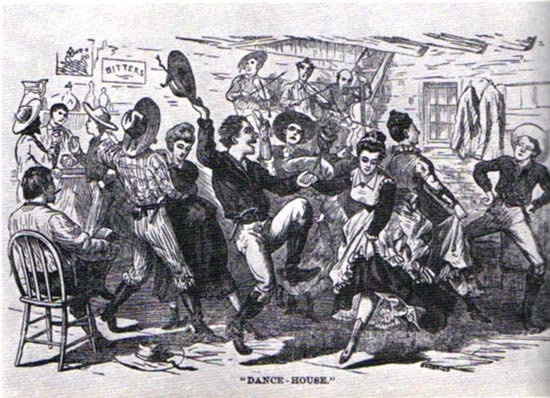
Western Dance House.
In Deadwood, Utter (1838-1912), often referred to as "Colorado Charley," organized a pony express carrying mail
from Deadwood to Cheyenne in as little as
48 hours for only twenty-five cents a letter. In Lead, a town apparently more prudish that Deadwood, Utter operated a "dance house," which was
closed down as a nuisance. Utter was an interesting character. Before organizing his wagon
train, he was a guide in the Colorado Rockies. He was noted for a bizarre habit; he insisted on taking
daily baths. When Jack McCall did in Wild Bill Hicock, Utter paid for the funeral and paid for the notice in the
Deadwood paper:
"Died in Deadwood, Black Hills, August 2, 1876, from the effects of a
pistol shot, J. B. Hickock [sic] (Wild Bill) formerly of Cheyenne, Wyoming.
Funeral services will be held at Charlie Utter's Camp, on Thursday
afternoon, August 3, 1876, at 3 o'clock, P. M. All are respectfully
invited to attend."
Two years later, the cemetery was full and Utter paid to have Hicock removed to
the new cemetery. It was then discovered that Wild Bill had been imperfectly embalmed.
As a result, calcium carbonate from the surrounding soil had replaced Wild Bill's
flesh and caused him to become petrified. In 1879, Deadwood City burned down and Utter disappeared from
the scene. Utter's ultimate fate is
subject to debate. Apparently based on coincidence of names, it has been speculated that he returned to
mining in Ruby City, Colorado, or became a saloonist in Socorro, New Mexico Territory. Writer Agnes Wright Spring,
Good Little Bad Man: The Life of Colorado Charley Utter, Pruett Publishing Company, 1987, contends that Utter ended up in
Panama as a physician. Indeed, in Panama City there was a Dr. Charles H. Utter who ran a drugstore and
perfumery, the Botica de Montezuma on Carrera del Istmo. The Panamanian Charles H. Utter was, however, apparently born in 1843. It is generally believed that
Charley Utter from Deadwood was born in 1838. The Ruby City Utter was born in
1831. There are some indications that Utter ended his days in San Francisco and died there in 1912.
Madam Mustache returned to San Fancisco where she committed suicide.
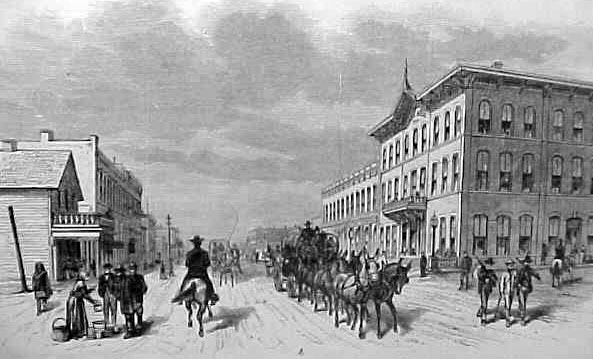
Inter-Ocean Hotel, Cheyenne, 1877, woodcut,
Leslies Illustrated News
In Cheyenne, shootings were not uncommon. In March 1877, as an example, the Leader reported that two
gamblers got into an exchange at Shingle & Locke's Saloon. There, St. Louis gambler,
C. H. "Charley" Harrison and Jim Levy got into an argument. Harrison insulted Levy by
telling Levy, that he, Harrison, hated
Irishmen. Levy, being Irish, took offense. [Writer's note: Levy was in fact
Irish, albeit of Jewish descent. Some writers have referred to him as
the "Jewish gunfighter."] The argument continued in front of the
Senate Saloon and ended in front of Frenchy's on Eddy Street when the two exchanged shots.
Levy, referred to by the Leader, as a "pistoliferous gambler," got the better of the
exchange. After a favorable prognosis, Harrison expired more than a week later in his
room at Dyer's Hotel. The Leader estimated that his funeral was attended by
"a majority of the sporting fraternity, with their wives, and other females."
Five years later in June 1882, Levy was gunned down in Tucson, Ariz. Terr., outside Hirem Stevens' Cosmopolitan Hotel by another gambler,
John Murphy along with Murphy's two cohorts, Gibson and Moyer. In October 1882, with the
connivance of the jailer, George Cooler, Murphy, Gibson, and Moyer, along with six others, escaped from the Pima
County Jail. For a short time, the three hid out southeast of Tucson in a cave which had been discovered
three years before by Cooler. Ultimately, the three were recaptured. Murphy and Moyer were found
guilty of the murder of Levy. Gibson was found not guilty on the basis that Levy was already
dead from Murphy and Moyer's bullets when Gibson's shot hit Levy.
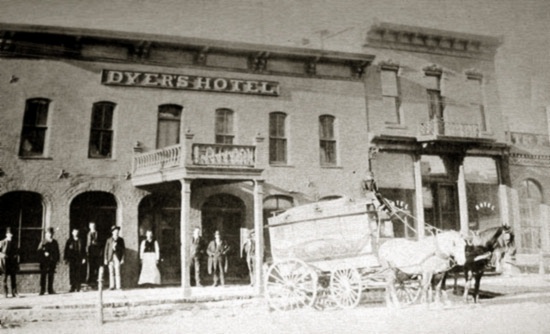
Dyer's Hotel, Eddy Street.
Timothy Dyer, born in Ireland, established one of the earliest hotels in Cheyenne. It was located on the
west side of Eddy Street (now Pioneer) between 16th and 17th Streets. Dyer served on the Board of
County Commissioners and was instrumental in establishing the Roman Catholic cemetery.
Not all, however,
was rough. By the end 1870's Cheyenne had put behind it a reputation of being a "Hell on Wheels."
Rapid transportation via railroad rapidly made Cheyenne, as indicated in the next views, a sophisticated city rivaling Denver.
Indeed, in some ways Cheyenne was more modern and sophisticated. As an example,
in 1882, the city was the first in the nation to illuminate its streets
with the newly invented electric incandescent lamps.
Indeed, during the decade between 1860 and 1870, Denver grew hardly at all.
With the coming of the
Railroad to Cheyenne, some Denver business persons moved to Cheyenne. The concern in Denver was that
it would be left high and dry and that Cheyenne would become the Queen City of the Plains and Mountains.
As a result, a number of Denver businessmen formed the Denver-Pacific Railroad and Telegraph Company
to connect Denver to the UPRR at Cheyenne. The first train pulled into Denver in 1870.
The traces of those who came from Denver may still be found. Campstool Road is named after
the Campstool Ranch established by Daniel Ullman. Ullman
arrived about 1870 from Denver where he had operated a meat market on Blake Street.
The move from Denver, however, may have led to a breakup of Ullman's marriage. Ullman's
wife, Harriet, refused to follow and stayed in Denver where she apparently operated a sporting parlor. Not withstanding that Mrs.
Ullman reported for the 1880 census that she was divorced, upon Ullman's death
in 1896, Mrs. Ullman appeared upon the scene and attempted to claim a widow's homestead
right.
Music this Page: RED WING
(As performed on the Banjo)
I
There once was an Indian maid a shy little prairie maid
who sang all day a love song gay
as through the fields she'd while the hours away.
She loved an Indian brave this shy little prairie maid
and then one day he rode away to battle far away.
(Chorus)
Oh the moon shines tonight on pretty Red Wing,
the breeze is sighing, the night birds crying,
For a far far away her brave is dying
and Red Wings's crying her heart away.
II
She watched for him day and night,
She kept all the campfires bright,
And under the sky,
Each night she would lie,
And dream about his coming by and by
But when all the braves returned
the heart of Red Wing yearned
for far far away her warrior brave fell bravely in the fray.
(chorus)
Now the Moon shines tonight on pretty Redwing,
the breeze is sighing, the night birds crying,
for a far'neath his star her brave is sleeping,
while Redwing's weeping her heart away.
Next page, cheyenne continued..
|